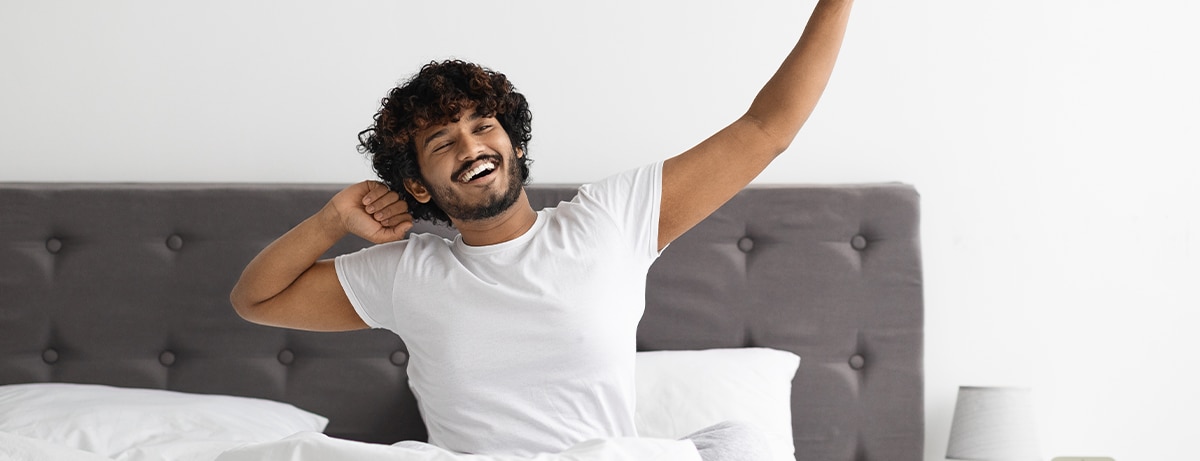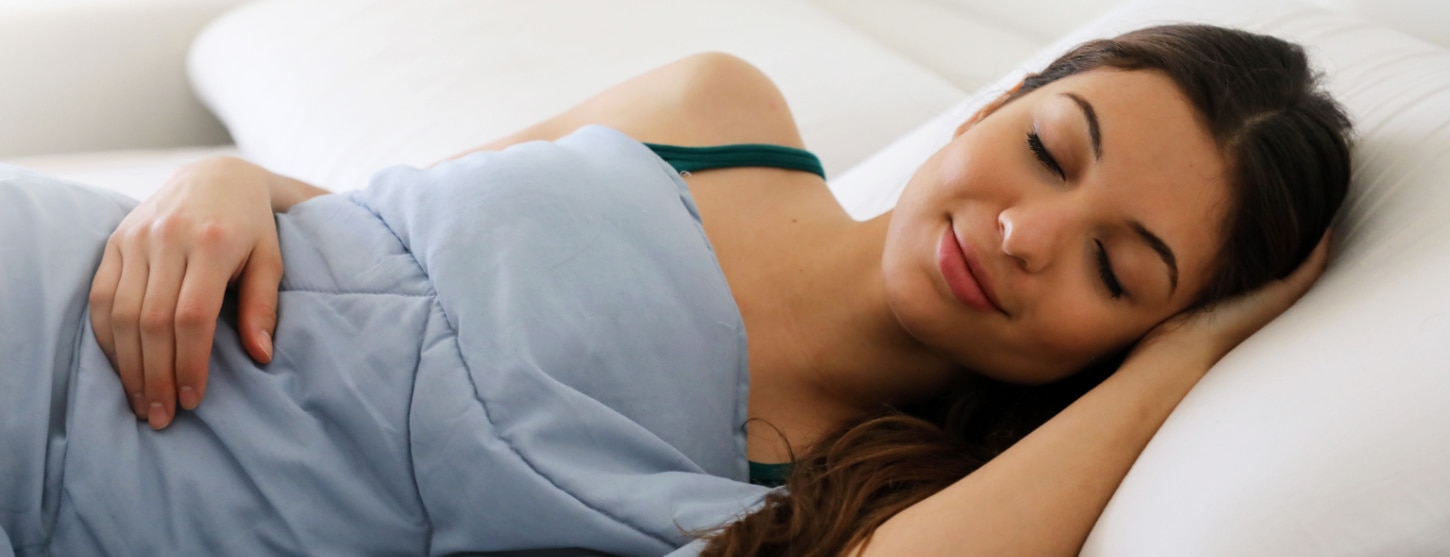15% off £40
Code:QUICK
The circadian rhythm – everything you need to know

Feeling tired lately? Your internal body clock might be broken, so here’s how to fix it
Summary
1What is the circadian rhythm?
According to Stephanie, “The circadian rhythm is the brain’s way of aligning the body with the environment…”
2What controls the circadian rhythm?
Time to get your brain in gear for the sciencey bit now… “Your circadian rhythm is controlled by a small area…”
3Why is the circadian rhythm important?
“It sets the pace for the body’s rest and repair. Deep sleep, for example, is vital for cell regeneration…”
Did you know that women are 40% more likely to have insomnia than men?1 And 54% of adults say stress and anxiety were the top reasons for having poor sleep?2
There are a lot of reasons why our sleep overall can be affected but the answers may lie in more than just your lifestyle habits. We spoke to Expert Behavioural Sleep Therapist, Stephanie Romiszewski to uncover everything there is to know about your circadian rhythm.
What is the circadian rhythm?
According to Stephanie, “The circadian rhythm is the brain’s way of aligning the body with the environment. It’s a set of physiological changes over a 24-hour-or-so period that is set by your internal body clock.”
“Our environment has an influence on this clock – most specifically light,” continues Stephanie. “This is why we sleep when it’s dark and we awake when it's light.”
“Nowadays though, things like electricity, technology, alarms and commuting times mean that many of us are keeping hours which might be at odds with our natural body clocks,” she says.
What controls the circadian rhythm?
Time to get your brain in gear for the sciencey bit now…
“Your circadian rhythm is controlled by a small area within the section at the base of your brain called the hypothalamus.3 The hypothalamus instructs the body to release certain chemicals and hormones during each 24-hour period,” explains Stephanie.
“The timing of these releases is in-built into our body clocks – but they’re also partly influenced by external factors, like whether it’s light or dark.”
“Light stimulates the production of cortisol – which wakes your body up and energises you for the day ahead,”4 she says.
Why is the circadian rhythm important?
“It sets the pace for the body’s rest and repair. Deep sleep, for example, is vital for cell regeneration. So, whenever you’re catching good quality sleep, your body is using that time to restore itself,”5 Stephanie explains.
How do circadian rhythms differ?
“Just like people, no two circadian rhythms are the same and can also change throughout our lives,” she says.
“When you’re a baby you sleep between 12-16 hours in a 24-hour period, reflecting the huge amount of growth that’s happening,” explains Stephanie. “Then when you’re aged one to five, you begin to synchronise with the light and dark circadian rhythm, and should get between 10-14 hours, including naps,” she says.
“Teenagers need between eight to 10 hours of sleep,”6 she says. “Teens have a developing circadian system,7 so can find early starts challenging (this isn’t just a myth!)”
National Institute of General Medical Sciences. Circadian Rhythms [Internet]. www.nigms.nih.gov. National Institute of General Medical Sciences; 2023. Available from: https://www.nigms.nih.gov/education/fact-sheets/Pages/circadian-rhythms.aspx
“Then, adults over 60 tend to be tired earlier in the evening and also wake up more during the night, usually waking up early.”8
What can disrupt the circadian rhythm?
“Unnatural light and the timing of our activities,” says Stephanie. “This could be electric lights, a street light, the glare of a TV, mobile or other electronic devices.”
“The blue light which comes from electronic devices can suppress melatonin production, which can stop you feeling tired, making it more difficult to drift off.”9
“Working shifts is another disruptor and can lead to insomnia and/or excessive sleepiness. It’s even been named Shift Work Disorder (SWD) by scientists,”10 she explains.
How can I improve my circadian rhythm?
“Firstly, give it routine and predictability,” explains Stephanie. “It's common for many people to believe that their early or late preferences are set in stone.”
“This is true to a degree, but more often it’s our behaviours that ‘set’ our preferences. We have more control than we think.”
Stephanie recommends the following to help…
“See waking up as a type of reset button,” she says. “By waking at the same time every day you’re controlling the amount of sleepiness you’ll have built up by the end of the day. Remember, sleep is a driving state; the longer you’re awake the greater the need to sleep.”
“By going to bed when you’re sleepy or tired and then waking up at the same time no matter what, you’ll start to notice you become sleepy around the same time each night,” explains Stephanie. “Don’t force it though as every day is different and you can’t control all the variables that affect how sleepy you feel.”
“Physical activity can help improve sleep quality, helping you feel less drowsy in the day and drop off easier at night,”11 says Stephanie. “Also, the natural daylight you get by being outside helps synchronise your circadian rhythm to the light/dark pattern.”
“If you exercise first thing, with a consistent wake time and plenty of light, you’re setting your body up as best as you can for the day and night ahead.”
“Keep the bed for sleeping, not scrolling,” says Stephanie. “Your brain will make you think you don’t want to sleep, and it’ll try to make you more awake. Not only are you delaying your sleep onset, but you’re potentially going to disrupt the quality of your sleep.”
“If you choose to do this and don’t have a natural separation between work and sleep where you can wind down, eat well and process your day, you’ll always be compromising on your sleep,” Stephanie explains.
The final say
It all sounds simple enough, but putting it into practice is another thing. Try doing one thing at a time by habit stacking, as this should help you feel less overwhelmed and hopefully make you stick to the positive changes.
The information in this article should not replace medical care. Please check with your GP or healthcare professional before trying any supplements, treatments or remedies.
Before taking any supplements or minerals, it’s best to make sure you’re getting all the nutrients through your diet first. This article contains the thoughts of Stephanie Romiszewski and Holland & Barrett cannot be held responsible for them.
1. Mong, J. A., & Cusmano, D. M. (2016). Sex differences in sleep: impact of biological sex and sex steroids. Philosophical transactions of the Royal Society of London. Series B, Biological sciences, 371(1688), 20150110. https://pubmed.ncbi.nlm.nih.gov/26833831/
2. Suni E. Sleep Statistics [Internet]. Truong K, editor. Sleep Foundation. 2023. Available from: https://www.sleepfoundation.org/how-sleep-works/sleep-facts-statistics
3. Bryan L, Guo L. What Is Circadian Rhythm? [Internet]. Sleep Foundation. 2023. Available from: https://www.sleepfoundation.org/circadian-rhythm
4. Leproult R, Colecchia EF, L’Hermite-Balériaux M, Van Cauter E. Transition from dim to bright light in the morning induces an immediate elevation of cortisol levels. The Journal of Clinical Endocrinology and Metabolism [Internet]. 2001 Jan 1;86(1):151–7. Available from: https://www.ncbi.nlm.nih.gov/pubmed/11231993
5. What Happens When You Sleep? - National Sleep Foundation [Internet]. Sleepfoundation.org. 2019. Available from: https://www.sleepfoundation.org/articles/what-happens-when-you-sleep
6. National Heart, Lung and Blood Institute. Sleep Deprivation and Deficiency [Internet]. Nih.gov. 2018. Available from: https://www.nhlbi.nih.gov/health-topics/sleep-deprivation-and-deficiency
7. Hagenauer MH, Perryman JI, Lee TM, Carskadon MA. Adolescent Changes in the Homeostatic and Circadian Regulation of Sleep. Developmental Neuroscience [Internet]. 2009;31(4):276–84. Available from: https://www.ncbi.nlm.nih.gov/pmc/articles/PMC2820578/
8. Duffy JF, Zitting KM, Chinoy ED. Aging and Circadian Rhythms. Sleep Medicine Clinics [Internet]. 2015 Dec;10(4):423–34. Available from: https://www.ncbi.nlm.nih.gov/pmc/articles/PMC4648699/
9. Tähkämö L, Partonen T, Pesonen AK. Systematic review of light exposure impact on human circadian rhythm. Chronobiology international [Internet]. 2018 Oct 12;36(2):151–70. Available from: https://www.ncbi.nlm.nih.gov/pubmed/30311830
10. VANTTOLA P, PUTTONEN S, KARHULA K, OKSANEN T, HÄRMÄ M. Employees with shift work disorder experience excessive sleepiness also on non-work days: a cross-sectional survey linked to working hours register in Finnish hospitals. Industrial Health. 2020 Feb 20;
11. Alnawwar MA, Alraddadi MI, Algethmi RA, Salem GA, Salem MA, Alharbi AA. The effect of physical activity on sleep quality and sleep disorder: A systematic review. Cureus [Internet]. 2023 Aug 16;15(8). Available from: https://www.ncbi.nlm.nih.gov/pmc/articles/PMC10503965/
Related Articles
Shop by wellness goal
Sign up for exclusive offers
Plus, get expert advice to support your health & wellness straight to your inbox when you sign up to Holland & Barrett emails.
Read our
privacy policy


















